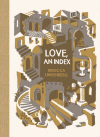Love, An Index
Rebecca Lindenberg’s first book of poems is concerned with loss. She takes up composing an extended elegy with little unnecessary adornment of sentiment. Lindenberg deserves credit for not making this book a clear-cut narrative of her years-long serious romance with the poet Craig Arnold, who vanished in 2009 while on a hiking visit to an active volcano—an apparent passion of his. In place of that, these are poems built of necessity; some happen to be soundings of specific moments of Lindenberg’s life with Arnold, but such concern remains secondary.
Rebecca Lindenberg’s first book of poems is concerned with loss. She takes up composing an extended elegy with little unnecessary adornment of sentiment. Lindenberg deserves credit for not making this book a clear-cut narrative of her years-long serious romance with the poet Craig Arnold, who vanished in 2009 while on a hiking visit to an active volcano—an apparent passion of his. In place of that, these are poems built of necessity; some happen to be soundings of specific moments of Lindenberg’s life with Arnold, but such concern remains secondary.
She allows details of her relationship with this “Oh, tall man” (“Which, if I Never Thought to Mention it Before, I Now Feel Compelled to Address”), to be yielded mention in the poems while never suffering her feelings for this “Tall, tall, tall, tall, tall man” to override or push beyond what’s called for by the occasion of the poetry itself. In other words, when she says in an interview on McSweeney’s website that the book “was well underway, about half written, when Craig vanished in April 2009” there’s no reason to doubt otherwise. It remains clear Lindenberg didn’t set out to capitalize on the death of her lover.
Though there are bits of poet’s gossip where Lindenberg does offer some details of her personal history with Arnold, it’s always not only of interest but structured in such a way which compliments possible readings of the poems. Throughout the book, the historical record is weaved in and out in a proper poetic evasion of traditional chronological recounting. We are offered facts more than anything. For instance, the poem “Love, a Footnote” consists of 14 statements beginning with:
1. The KGB Bar off 2nd Avenue in New York’s East Village was a gathering place for the Ukranian Communist Party, which explains the curious décor but not the frequent readings.
Throughout this particular poem, Lindenberg maintains a balance of situating what appears to be her original meeting of Arnold without it ever rolling over into being kiss-and-tell scenario. This is true for the book as a whole. Instead, a feeling is given for how the relationship developed as these two poets came to know one another in the various environments they found themselves surrounded by. For instance, sticking with the same poem:
12. Veselka is a Ukranian diner in the East Village, near St. Mark’s Church. Very good pierogi. Many of the customers have chic glasses, cases for musical instruments, and dirty hair. I like to sit at the counter.
This restaurant may prove worth knowing about on a reader’s next visit for a reading at The Poetry Project. While not the hippest guide to the poetry world, Love, An Index affirms that Lindenberg and Arnold’s relationship was one built out from an assuredly dedicated life to poetry. From the beginning of their earliest conversations, a healthy competitive edge appeared between the lovers, which at the time wasn’t entirely evident to each equally. This is also from the same poem as above:
8. Wallace Stegner’s comment about art as the communication of insight appears in various incarnations in his work, but my favorite is in Angle of Repose. You acted surprised that I had such a thought. I took it as a compliment at the time.
Lindenberg understands the risk of so openly expressing grief over a lost love via poetry; in the same interview previously cited, she says, “These poems were an experiment of a sort—and they’re quite sincere, but that’s not to say they aren’t also lucidly aware of their own (what is it?) ridiculousness? Excess, perhaps.” She isn’t averse to admitting a certain weakness to her book, yet she’s aware of how there’s also simultaneously a strength to be found. As long as she’s attentive to the needs of the poems, there’s a chance of successfully pulling off the project. She stresses that “it is also important to remember that elegy is a story of change—elegy, true elegy, culminates in some kind of coming-to-terms. It can hold onto the affirmation without requiring the grief. Elegy takes our attachment and desire and longing and sublimates it into song.” And the celebration such “song” offers as a site for both reflection and renewal is amply demonstrated in this collection, as with “Still Life with Movement”:
On this
cedar table all
the quiet volition
of the world underway,
becoming, then
becoming anew.
Lindenberg sublimates her personal concerns (emotions over her loss and memories of Arnold) in service to wielding the poems as a tool of more than mere recovery. As noted in “Dispatches from an Unfinished World,” these poems enter into “Kinds of holiness.” Wonder and delight.





